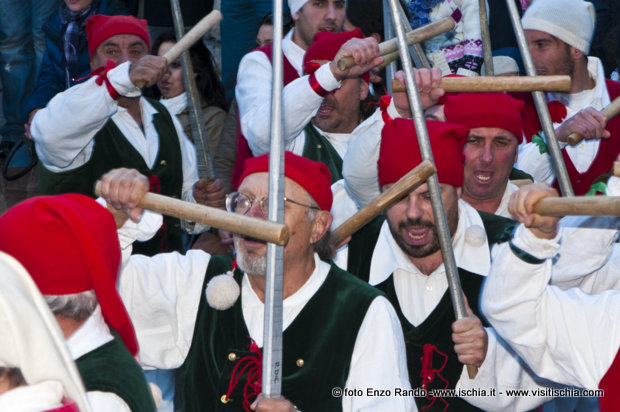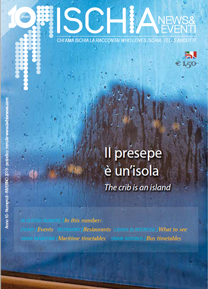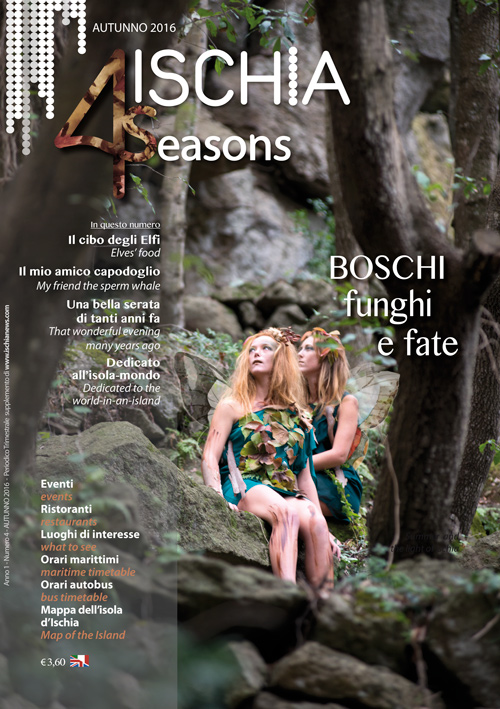Buonopane in St. Giovanni celebration and Ndrezzata

Barano is one of the six municipalities of the island of Ischia established during the French domination of the Kingdom of Naples in 1806. It is the second largest land (12 km2). Its population is about 9.000 inhabitants scattered in 4 fractions (Piedimonte, Fiaiano, Buonopane and Testaccio). One of these ones - Testaccio - was also an independent town from 1806 to 1873. At the Piazza of San Rocco - the center of the city located about 200 meters above sea level - one comes from Ischia Porto through the state highway ex-270, now provincial, which circumnavigates the island,
from the central square you can go even higher to Buonopane, the village located about 280 meters above sea level with a population of 1400 inhabitants, to discover an Ischia neglected by mass tourism, the island of rural traditions and “oral history”.
“Here we had only one major character, Angelo Migliaccio, a lawyer who was Mayor of Barano 1849 to 1859, our ancestors were farmers and since the eighteenth century the surnames of the families have remained the same: Di Costanzo, Di Meglio the Di Iorio, Balestrieri, Migliaccio”, Pasquale Balestrieri says, an Italian professor of history, and for forty years in high school and above all a poet but also peasant tied to traditions of their ancestors, and which is, after nearly two centuries, a “major character” from Buonopane, respected and loved by all.
These farming families have preserved in a way, that is still mysterious to students of history, one of the oldest traditions of the island of Ischia: the dance of ‘Ndrezzata’ to which eighteen dancers participate aka “weavers”, four players - two clarinets and two drums - which give the rhythm to dance of ancient origins. At the ‘Ndrezzata band are involved only people of Buonopane and the dance technique is transmitted from generation to generation, from father to son.
“The origins of dance are lost in the mists of time - says Professor Balestrieri - but it is likely to be a dance of Greek origins, anyway the Greeks were the first colonizers of the island of Ischia”. But as this dance has stopped here in a village, far from the city founded by the Greeks of Pithecusa in the eighth century B.C. in today’s Lacco Ameno, is still a mystery.
“Probably we will never know - said prof. Balestrieri – as well as we will never know for sure if the ‘Ndrezzata’ is a war dance or a ballet of love, what is certain is that it is the last expression of authentic folklore of the island of Ischia”.
The eighteen dancers, having in the lead a ‘corporal’, who today is Giovanni Emiddio Buono who begins with a “sermon” in old Neapolitan language, place in two concentric lines of nine dancers each grasping with their right hand a blow and a wooden sword with their left hand, then under the command of ‘corporal’ and at the rate of the players, are intertwined with each other exchanging blows and sword, frontal and lateral.
The dance lasts a very short time - eight, ten minutes - but it requires considerable preparation and training by the dancers.
“The text’s dance dates back to the eighteenth century – Prof. Balestrieri says - and is probably a hymn to female fertility, to the woman, to the love between the two sexes”. The liberating value of dance is to be tried by the Buonopane days devoted to this rite. The "Ndrezzata", in fact, takes place in the churchyard of St. John the Baptist, the only one of the village, only two times a year: Easter Monday and June 24, St. John’s day, patron of the village.
“The Ndrezzata takes place on June 24 immediately after the evening Mass and before the procession with the statue of St. John in leaded by the parish priest Don Francesco Mattera” says Prof. Balestrieri.
" C'è un racconto popolare, trasmesso via orale di padre in figlio, secondo il quale capitò molto tempo fa che durante la processione arrivò una fitta pioggia e la statua di San Giovanni dovette essere ricoverata in una cantina. Così gli abitanti di Fontana dileggiarono i buonopanesi perché avevano fatto passare San Giovanni per ubriacone. Ma San Giovanni si vendicò e mentre a Buonopane cadeva la pioggia a Fontana cadeva la grandine andando a distruggere i grappoli d' uva che davano il vino, il principale prodotto della terra per la sopravvivenza" racconta Balestrieri.“There is a folk tale, transmitted orally from father to son, according to which happened long ago that during the procession came a heavy rain and the statue of St. John had to be hospitalized in a cellar. So the residents of Fontana derided the Buonopane people because they made He out to be a drunkard. But St. John retaliated and while in Buonopane the rain fell, in Fontana fell the hail going to destroy the bunches of grape that gave the wine, the main product of the land to the survival”, Balestrieri says.
There is no rain on Sunday, on June 24, 2012 ... but a meeting in a basement in Buonopane for a good glass of wine after watching the performance of Ndrezzata, followed the procession and thanked St. John, one can make perfectly a plan!
Giuseppe Mazzella


















